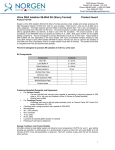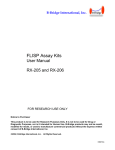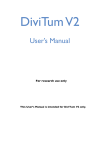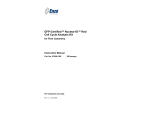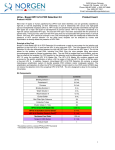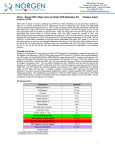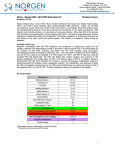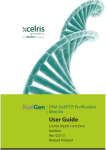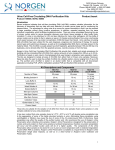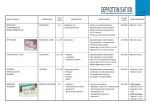Download 18100 - Protocol
Transcript
3430 Schmon Parkway Thorold, ON, Canada L2V 4Y6 Phone: 866-667-4362 • (905) 227-8848 Fax: (905) 227-1061 Email: [email protected] Urine DNA Isolation Kit Product Insert Product # 18100 Norgen’s Urine DNA Isolation Kit provides a fast, reliable and simple procedure for isolating DNA from as low as 50 µL of urine (See Application Note). DNA found in urine can be divided into 2 basic categories. The larger species, genomic-DNA (gDNA), is generally greater than 1 kb in size, and appears to be derived mainly from exfoliated cells (See Figure on page 6). The second species is smaller, generally between 150 and 250 bp (apoptotic-DNA), and derives, at least in part, from the circulation. The second species is also considered as an RNA/DNA hybrid as reported by Halicka et al. (2000). Both types of DNA can be isolated reliably using this kit. Typical yields of DNA isolated will vary depending on the input sample, with more concentrated samples tending to yield more DNA. Preparation time for a single sample is about 30 minutes. The purified urine DNA is compatible with most molecular biological applications such as PCR, q-PCR, Southern Blot, etc. This kit is designed to process 50 urine samples with a volume of 1.75 mL or less. Kit Components: Component Contents Binding Solution I 15 mL Proteinase K in Storage Buffer 2 mL Pronase in Storage Buffer 2 mL Binding Solution II 8 mL (1) Wash Solution I 8 mL (2) Wash Solution II 25 mL Elution Buffer 9 mL Micro Spin Columns 50 Collection Tubes 50 Elution tubes (1.7 mL) 100 Product Insert 1 (1) Note: you must add 22 mL of ethanol (96 - 100%) to activate Binding Solution II (2) Note: you must add 22 mL of ethanol (96 - 100%) to activate Wash Solution I Customer-Supplied Reagents and Equipment • Benchtop microcentrifuge • Micropipettors • 96 – 100% ethanol • 60°C incubator Storage Conditions and Product Stability o All buffers should be kept tightly sealed and stored at room temperature (15-25 C) for up to 1 year without showing any reduction in performance. Norgen’s Urine DNA Isolation Kit contains ready-to-use Proteinase K and Pronase solutions, which are dissolved in a specially prepared storage buffer. The Proteinase K and the Pronase are stable for up to 1 year after delivery when stored at room temperature. To prolong the lifetime of Proteinase K and Pronase, storage at 2–8°C is recommended. Quality Control In accordance with Norgen’s Quality Management System, each lot of Norgen’s Urine DNA Isolation Kit is tested against predetermined specifications to ensure consistent product quality. 1 Product Use Limitations Norgen’s Urine DNA Isolation Kit is designed for research purposes only. It is not intended for human or diagnostic use. Product Warranty NORGEN BIOTEK CORPORATION warrants that its products shall conform to the description as provided in our current catalog. This warranty is exclusive and Norgen Biotek Corporation makes no other warranty, expressed or implied, including any implied warranty of merchantability or fitness for any particular purpose. Norgen Biotek Corporation’s sole and exclusive liability, with respect to products proved to Norgen Biotek Corporation’s satisfaction to be defective, shall be the replacement of such products without charge or refund of purchase price. Norgen Biotek Corporation shall not be liable for any incidental, consequential or contingent damages. Safety Information Ensure that a suitable lab coat, disposable gloves and protective goggles are worn when working with chemicals. For more information, please consult the appropriate Material Safety Data Sheets (MSDSs). These are available as convenient PDF files online at www.norgenbiotek.com. CAUTION: DO NOT add bleach or acidic solutions directly to the sample-preparation waste. The Binding Solution I, Binding Solution II, Wash Solution I and Wash Solution II contain guanidine hydrochloride, and should be handled with care. Guanidine hydrochloride forms highly reactive compounds when combined with bleach, thus care must be taken to properly dispose of any of these solutions. If liquid containing these solutions is spilt, clean with suitable laboratory detergent and water. If the spilt liquid contains potentially infectious agents, clean the affected area first with laboratory detergent and water, and then with 1% (v/v) sodium hypochlorite. Notes prior to use: • We recommend the use of Norgen’s Urine Preservative when collecting urine samples, which is designed for the preservation of nucleic acids and proteins in fresh urine samples at ambient temperatures. The components of the Urine Preservative allow samples to be stored for over 2 years at room temperature with no detected degradation of urine DNA, RNA or proteins. Norgen’s Urine Preservative is available in 2 convenient formats: in a liquid format in Norgen’s Urine Preservative Single Dose Ampules, as well as in a dried format in Norgen’s Urine Collection and Preservation Tubes. Please see the Related Products table below. • First time users should read the entire manual before proceeding with the protocol. • Do not spin down or filter the urine sample before proceeding with the isolation, as this could decrease the DNA yield. • Ensure that all solutions are at room temperature prior to use, and that no precipitates have formed. If necessary, warm the solutions and mix well until the solutions become clear again. • Always vortex both the Proteinase K and the Pronase before use. • Prepare a working concentration of Binding Solution II and Wash Solution I by adding the proper volume of 96-100% ethanol indicated in Table 1 below (provided by the user) to the supplied bottle containing the concentrated Binding Solution II and Wash Solution I. The label on the bottle has a box that may be checked to indicate that the ethanol has been added. • Preheat an incubator or heating block to 60°C. • This protocol is optimized for an input of 1.75 mL of urine, however it is possible to process 50 µL – 2.6 mL of urine. Ensure that the volumes of the solutions are adjusted accordingly based on the urine input. 2 Table 1: Volume of Ethanol to be added to Binding Solution II and Wash Solution I Volume Provided Ethanol Added (96-100%) Final Volume Binding Solution II 8 mL 22 mL 30 mL Wash Solution I 8 mL 22 mL 30 mL Detailed Procedure - (Adjust the volumes accordingly if you are processing a different urine volume) 1. Add 250 µL of Binding Buffer I for every 1.75 mL urine sample. Mix well by inverting a few times; 2. Apply 650 µL of the urine sample onto a column and centrifuge for 1 minute at 6,700 x g. Discard the flowthrough and reassemble the spin column with its collection tube. Note: If the entire volume does not pass through into the collection tube the column can be spun for an additional minute; Repeat Step 2 until the entire urine sample has passed through the column. 3. Add 35 µL of Proteinase K and 35 µL of Pronase to each column and centrifuge for 1 minute at 6,700 x g. Do Not Discard the Flowthrough, as it contains the DNA; 4. Incubate the column and collection tube at 60°°C for 20 minutes; 5. After the 20 minute incubation, add 450 µL of Binding Buffer II to the lysate in the collection tube, mix well by pipeting and then transfer the entire contents of the collection tube back onto the spin column; 6. Centrifuge for 1 minute at 6,700 x g. Discard the flow-through; 7. Apply 450 µL of Wash Solution I to the column and centrifuge for 1 minute at 14,000 x g (~14,000 RPM). Discard the flowthrough and reassemble the spin column with its collection tube; 8. Apply 450 µL of Wash Solution II to the column and centrifuge for 1 minute at 14,000 x g (~14,000 RPM). Discard the flow-through and reassemble the spin column with its collection tube; 9. Apply 450 µL of 96-100% ethanol (supplied by the user) to the column and centrifuge for 1 minute at 14,000 x g (~14,000 RPM). Discard the flow-through and reassemble the spin column with its collection tube; 10. Repeat Step 9 a second time; 11. Spin the column, empty, for 1 minute at 14,000 x g (~14,000 RPM). Discard the collection tube; 12. Incubate the column horizontally for 3 minutes at 60°C; 13. Transfer the spin column to a fresh Elution Tube. Apply 75 µL of Elution Buffer to the column and centrifuge for 2 minutes at 200 x g (~2,000 RPM), followed by 1 minute at 14,000 x g (~14,000 RPM); 14. Transfer the spin column to a second fresh Elution Tube. Apply 75 µL of Elution Buffer to the column and centrifuge for 1 minute at 14,000 x g (~14,000 RPM). Urine DNA is now ready for downstream applications. 3 Rapid Flow Chart Procedure Place 1.75 mL urine sample in a 2 mL tube Add 250 µL Binding I Load sample to the column (650µL x 3) SPIN 6,700 x g, 1 min Add 35 µL Proteinase K and Pronase SPIN 5,000 x g, 1 min Do Not Discard Flowthrough o Incubate 20 min at 60 C Add 450 µL Binding II to the lysate in the collection tube Mix, Transfer the whole content back into the same spin Column SPIN 6,700 x g, 1 min Wash twice with 450 µL Wash Solutions SPIN 14,000 x g, 1 min Wash Twice with 450 µL 95-100% Ethanol Dry Column SPIN 14,000 x g, 1 min Elute DNA with DNA elution buffer Dry SPIN 14,000 x g, 1 min E1 (75 µL) E2 (75 µL) Purified Total DNA 4 Frequently Asked Questions 1. If I am not going to process my samples immediately, how should I store my samples? • We recommend the use of Norgen’s Urine Preservative when collecting urine samples, which is designed for the preservation of nucleic acids and proteins in fresh urine samples at ambient temperatures. Urine samples in the preservative should be stored at room temperature. Turbidity or precipitation may be observed if the urine samples are stored at either 4°C or at -20°C. DO NOT discard this precipitate and/or spin down your samples to get rid of the turbidity; this will significantly reduce your DNA yields. Make sure to mix your samples thoroughly before processing. 2. What if a variable speed centrifuge is not available? • A fixed speed centrifuge can be used, however reduced yields may be observed. 3. What will happen if my centrifugation speed varied from the recommended speed? • This may lead to the degradation of the genomic DNA or reduction in the total DNA yields. 4. At what temperature should I centrifuge my samples? • All centrifugation steps are performed at room temperature. Centrifugation at 4°C will not adversely affect kit performance. 5. My centrifuge speeds are defined in rpm and not in g-force. How can I convert g-force to rpm? • The correct rpm can be calculated using the formula: RPM = RCF (1.118 x 10-5) (r) Where RCF = required gravitational acceleration (relative centrifugal force in units of g); r = radius of the rotor in cm; and RPM = the number of revolutions per minute required to achieve the necessary g-force. 6. Can I process a different urine volume? • Yes, you can. All the buffers included in this kit are in a linear relationship to the volume of urine sample processed. Make sure that you do not deviate from the ratio specified in the product manual. The minimum recommended urine input is 50 µL, and the maximum recommended input is 2.6 mL. Please note that the buffers are optimized for an input of 1.75 mL of urine. 7. What if I added more or less from the specified reagents’ volume? • Adding less volume may reduce your DNA yields. Adding more may not affect the DNA yields EXCEPT if more Elution Buffer was added. Eluting DNA in a higher volume of Elution Buffer will result in diluting your DNA. 8. Can I pass more than 1.75 mL of urine through this column? • Yes, you can pass up to 2.6 mL of urine (650 µL x 4 spins) through the column. If more than 2.6 mL of urine is passed through the column the column will be saturated. If more samples need to be processed, you can use the Urine DNA Isolation Mini or Maxi Kit (Slurry format) (see related products). 9. What if my incubation temperature varied from the specified 60°°C? • The incubation temperature can be in the range of 55°C - 65°C. If the temperature is outside of that range the activity of both the Proteinase K and the Pronase will be reduced. This will result in a reduction in your DNA yields. 10. What if my incubation varied from the 20 minutes specified in the product manual? • Less than 20 minutes will result in a lower DNA yields. More than 20 minutes may not affect your DNA yields. 11. What if I forgot to do a dry spin after my second wash? • Your first DNA elution will be contaminated with traces of the Wash Solution. This may dilute the DNA yield in your first elution. Also, it may interfere with your downstream applications. Re-isolate the eluted DNA using the same procedure as you initially isolated the DNA from urine but using the first elution as your input. 5 12. Can I perform a third elution? • Yes, you can. A third elution is possible, but it is recommended that this elution be performed in a smaller volume (50 µL). 13. Why am I eluting my DNA into two elutions? • The first elution will mainly contain the low nucleic acid species and traces from the large DNA species. However, your second elution will mainly contain the large DNA species and traces from the low nucleic acid species. 14. Why did my samples show very low DNA yields? • Some urine samples contain very little DNA. This varies from individual to individual based on numerous variables. In order to increase the yield, the amount of urine input could be increased. Increasing the incubation time at 65ºC (up to overnight) could also result in increased yields. 15. Why does my DNA not perform well in downstream applications? • If a different Elution Buffer was used other than the one provided in the kit, the buffer should be checked for any components that may interfere with the application. Common components that are known to interfere are high salts (including EDTA), detergents and other denaturants. Check the compatibility of your elution buffer with the intended use. 16. What is the expected DNA yield from urine? • The urinary DNA yield varies between individual samples. Generally, the DNA yield ranges between 50 ng – 2 µg/mL of urine sample. In many cases, DNA yields from urine are too low to be visualized on an agarose gel; however, the DNA yield is sufficient for most downstream applications including PCR and Southern hybridization. (See Figure below) Sample 2 Sample 1 M 2000 1500 1000 750 500 300 150 50 E1 E2 E1 Sample 3 E2 E1 E2 Large DNA species Circulating DNA DNA/RNA mixture Figure. A typical 1.2% agarose gel showing total urinary DNA isolated from different urine samples using Norgen’s Urine DNA Isolation Micro Kit. This gel shows the variability in the DNA yield which can be observed with different urine samples. This gel also shows the different DNA types which can be isolated from urine. Each lane shows one tenth from each elution (i.e. E1: 7.5 µL out of 75 µL were loaded on the gel, E2: 7.5 µL out of 75 µL were loaded on the gel). M: 10 µL Norgen’s FastRunner DNA Ladder. Technical Assistance NORGEN’s Technical Service Department is staffed by experienced scientists with extensive practical and theoretical expertise in sample and assay technologies and the use of NORGEN products. If you have any questions or experience any difficulties regarding Norgen’s Urine DNA Isolation Kit or NORGEN products in general, please do not hesitate to contact us. NORGEN customers are a valuable source of information regarding advanced or specialized uses of our products. This information is helpful to other scientists as well as to the researchers at NORGEN. We therefore encourage you to contact us if you have any suggestions about product performance or new applications and techniques. For technical assistance and more information, please contact our Technical Support Team between the hours of 8:30 and 5:30 (Eastern Standard Time) at (905) 227-8848 or Toll Free at 1-866-667-4362. or call one of the NORGEN local distributors (www.norgenbiotek.com) or through email at [email protected]. 6 Related Products Urine DNA Isolation Kit (Mini slurry Format) Product # 27000 Urine DNA Isolation Kit (Maxi slurry Format) 27200 Urine (Exfoliated Cell) DNA Purification Kit 22300 Urine (Exfoliated Cell) RNA Purification Kit 22500 Urine Bacteria DNA Purification Kit 22400 Urine Bacteria RNA Purification Kit 23400 Urine Collection and Preservation Tubes (50 cc) – 1 tube 18111 Urine Collection and Preservation Tubes (50 cc) – 50 tubes 18113 Urine Collection and Preservation Tubes (15 cc) – 1 tube 18120 Urine Collection and Preservation Tubes (15 cc) – 50 tubes 18122 Urine Collection and Preservation Tubes (5 cc) – 1 tube 18116 Urine Collection and Preservation Tubes (5 cc) – 50 tubes 18118 Urine Preservative Single Dose – 1 tube 18124 Urine Preservative Single Dose – 50 tubes 18126 References Halicka, H. D., Bedner, E. and Darzynkiewicz, Z. (2000). Segregation of RNA and separate packaging of DNA and RNA in apoptotic bodies during apoptosis. Exp Cell Res. 260, 248-256. M. Abdalla and Y. Haj-Ahmad. (2006).Urinary Proteomic and Genomic Profiles from Hepatitis C virus, Hepatitis B Virus, and Hepatocellular Carcinoma Patients. Molecular & Cellular Proteomics. ASBMB, S369 Application Note: http://www.norgenbiotek.com\tech downloads\Application Notes\Application Note 10 - Urine DNA.pdf 3430 Schmon Parkway, Thorold, ON Canada L2V 4Y6 Phone: (905) 227-8848 Fax: (905) 227-1061 Toll Free in North America: 1-866-667-4362 © 2010 Norgen Biotek Corp. PI18100-16 7







